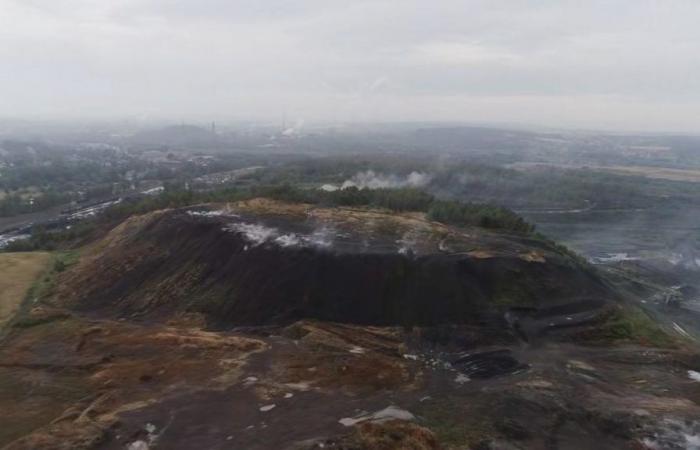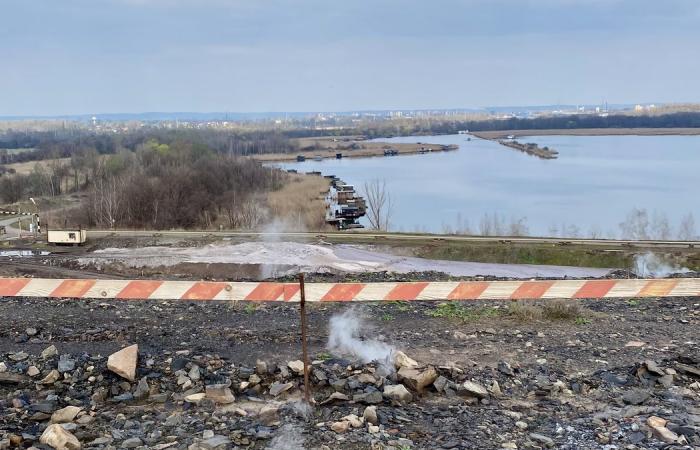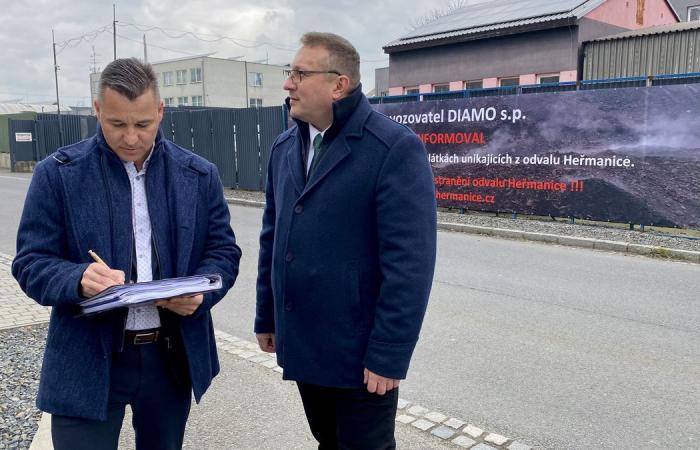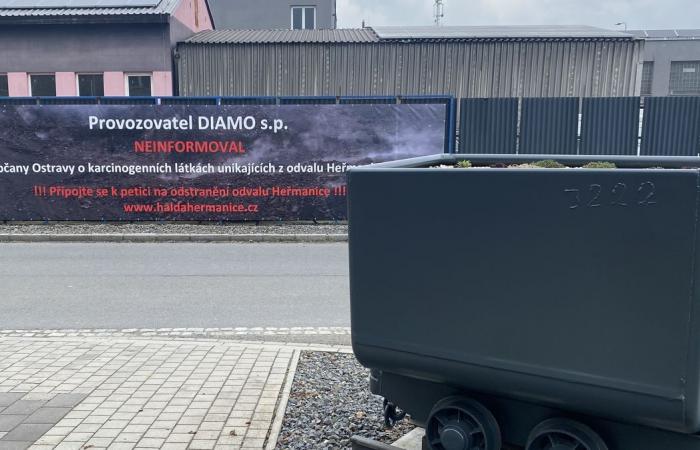This is not only feared by OKK Koksovny, whose landfill it is, but also experts from the fire and rescue service, among others, and this is also pointed out by the opinion of an expert commissioned by the state-owned enterprise DIAMO. He is the one responsible for the burning dump. At the current rate, according to Koksoven, the landfill could catch fire in about two years.
Yet no one in charge seemed to care. The dump on the outskirts of Ostrava, a stone’s throw from residential areas, a prison or a logistics park, has been burning and smoking for over twenty years. It cannot be missed and most of the locals have got used to it. As they get used to being sick, many die prematurely of cancer and Ostrava is a constant in the ten European cities with the worst air.
The largest and most poisonous
I walk along one of the many hills of the smoldering heap and look at Ostrava. Getting here is not difficult. I came from just a few hundred meters away from that hazardous waste dump, where three thousand cubic meters of dangerous substances based on tars, polycyclic aromatic hydrocarbons, phenols… That is, highly flammable and toxic substances related to the production of coke, are stored and sealed under the soil layer. .
Ostravans spend like fish in Bečva, people are angry because of the burning heap of Heřmanice
Homemade
From there, it takes a few minutes to walk here, to the first places where signs of burning are visible. You can not only see the burning, but also feel it under your feet. It’s not a pleasant feeling. I’m going on, I’m going higher. Within minutes my head hurts and my stomach starts to churn. But you don’t have to climb the vast, smoldering pile of the body of the heap, just a walk along the embankment of the Heřmanické Pond, a site of European significance and a Natural Monument, is enough to make you sick.
Photo: Adéla Knapová, Law
A site of European importance begins right next to the heap.
This is another of the many sad quirks of the avalanche. This far and away the largest thermally active – i.e. burning – toxic heap, releasing poisonous fumes into the air like several hundred thousand solid fuel boilers at once, rises only a few tens of meters from a sheltered and seemingly idyllic place with fishing huts in reeds and flocks of waterfowl on the surface.
Another pile of soot and polluting air in Ostrava, one would like to say. The people of Ostrava are used to it, and apparently it won’t be such a big problem, because at least the local municipality or the region would do something about it – it was this way of trivializing it that caused nobody to deal with the burning heap for so long.
Because yes, in Ostrava and in neighboring Poland, several heaps and remains of mining activity are really burning with underground fires. However, the Heřmanické avalanche is not only the largest, but also the most risky. And not only because of the proximity of the hazardous waste dump. It contains both coal residues and sulfur compounds, as well as toxic waste from coke plants and chemical plants.
Definitely carcinogenic
“The dump contains tens of millions of tons of tailings with the rest of the coal and has been burning for more than twenty years. Given that there is gradually weighted waste of unknown composition on the site, the source of emissions are the products of the combustion process – carbon and carbon dioxide, various hydrocarbons, including aromatic and polyaromatic. Many of them are carcinogenic,” says Professor Ivan Holoubek, one of our greatest experts on chemical pollution.
“When it comes to the possible burning of weighted hazardous waste, it is difficult to estimate what all the toxic substances can be emitted into the environment. For the monitored parameters, the concentration of benzoapyrene exceeds the limit, which is alarming due to the possible impact on human health. For me, it is completely incomprehensible that all this is happening without the competent authorities, whether local or state, including the Czech Environmental Inspectorate, vigorously solving the problem,” Holoubek continues, adding that the carcinogenic effect of the aforementioned benzopyrene has been clearly proven.

Photo: Adéla Knapová, Law
One of the largest dumps in Europe has been releasing toxic and carcinogenic substances by burning without access to air for over two decades
At the same time, there was no public discussion of the heap until the fall of last year. Like she wasn’t. It wasn’t until Coke Soven’s concerns about its burnout at the hazardous waste dump that its representatives contacted the media. According to their spokesman, Jindřich Vaňek, they have exhausted all other options to get other interested parties, including state and self-governing bodies, to act and solve problems with the heap.
When I started looking into the heap last year, I discovered incomprehensible chaos and punishing laziness.
The state enterprise DIAMO was given the task of renovating the Heřmanice dump. In simple terms, he was supposed to gradually dismantle the pile, sort it and use what can be (gravel, etc.) again somewhere. In this way, the pile should disappear completely. However, DIAMO’s activity – or rather inactivity, as it now appears – has only led to the fact that the pile and the pollution from it are not decreasing. On the contrary – a black dump has grown on the heap, among other things, in recent years.
There are problems here
Nevertheless, the state is basically not dealing with this ecological burden that threatens to be a disaster. At the same time, both the Ministers of Industry and Trade and the Environment, the Czech Environmental Inspectorate, the Mining Office…, as well as the Municipality of the City of Ostrava and the Moravian-Silesian Region are aware of it. Many of the mentioned have been communicating with each other on the subject of Heřmanické heaps for years – I am going through stacks of correspondence and conclusions of various commissions and meetings. For years, responsible persons and organizations have been sending each other letters demanding explanations, seemingly looking for a solution, one making excuses for the other, shifting responsibility. At the center of this event without a positive result is the state-owned enterprise DIAMO. Its director, Ludvík Kašpar, often personally attends meetings where he explains why the landfill is not being rehabilitated and who is to blame
Director Kašpar told me, among other things, that DIAMO would really like to “solve” the pile, but due to a complicated situation for which someone else is to blame (I am receiving another batch of documents, the conclusions of which contradict the conclusions of other studies and materials, sometimes contradicting themselves), that it’s not that easy.
The director of DIAMO also acknowledges that there are problems at the Heřmanické dump. They even filed a criminal complaint. It is possible that they actually filed the report against themselves, he explains, but the conclusion of the police is decisive. The new one reads that it is not a crime, but the waste law may have been violated. The police then handed the case over to the Czech Environmental Inspectorate.
Ludvík Kašpar does not even deny the harmfulness of the heap – according to him, however, the important question is how much harm it does. Certainly not as much as claimed.
The problem is that the measurements and numbers that DIAMO operates with don’t match other numbers and measurements. And so we are in a situation where most of those who deal with the dump say something completely different about pollution than DIAMO. Because, as the press spokesman of the state-owned company Tomáš Indrei repeats: “The influence of the Hermanice avalanche on the air in its immediate vicinity is not significant.”
Concerns of the European Commission
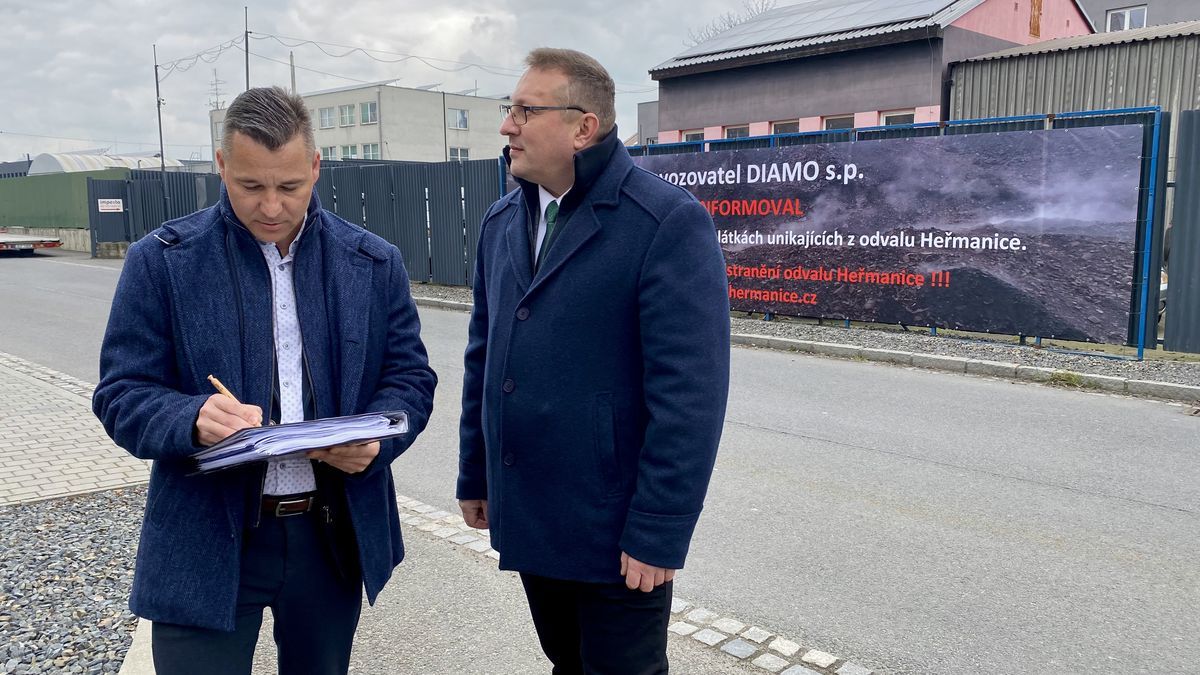
Photo: Adéla Knapová, Law
Deputy Aleš Boháč (left) signs a petition to Jiří Michalisk. Behind them you can see a billboard that the latter had made and placed in front of the entrance to the Ostrava branch of DIAMO
The deputy mayor of Ostrava, Aleš Boháč, disagrees with this, and on behalf of the municipality, he started the fight with the pile most vigorously. He shows me piles of charts, graphs, images from thermometry… He says he is literally bombarding the responsible places, including the ministries, so that they finally start doing something. His experience is similar to mine – everyone makes excuses (if they answer at all) and points to someone else. He adds that at least the Ministry of Industry and Trade has moved after many months. “Late and little, but still,” he shrugs.
Regarding the real situation at the dump, he says: “If DIAMO really wants to rehabilitate, as director Kašpar claims, then he must finally start doing it. He has to start taking the burden off. According to valid permits, there is nothing to prevent it.”
He adds that in at least four cases he proved to Ludvík Kašpar that they had been given deliberately false information about the heap: “I asked him to finally reevaluate his position and work schedule and tell me when they will start rehabilitating the heap. It is obvious that they are just making excuses and delaying. This is unacceptable to me. This is about the health of all of us.”
His words indirectly confirmed the answer of the DIAMO press spokesperson to my question about the current situation with the dump: “Based on the meetings of the interdepartmental group, the state enterprise DIAMO is currently preparing an analysis of the fundamental parameters of possible technical solutions for the rehabilitation of the Heřmanice dump, in particular the evaluation of the impact of the methods environmental remediation and their time and financial demands. DIAMO has to complete this task by June 20, 2024, when the interdepartmental group established by the Minister of Industry and Trade, Jozef Síkela, will meet again in Ostrava.”
“They’re only doing this now? After so many years?!” Aleš Boháč throws up his hands. Moreover, the problem of the toxic dump is no longer “just” local, the European Commission is also interested in it. It was the Commission that Deputy Boháč turned to regarding the pile, and he recently received a letter from Brussels, which we have at our disposal. In it, among other things, it is written about the problem: “The European Commission is concerned about the persistent violation of EU standards for air quality… The Commission’s departments have turned to the Czech authorities in this matter.”
Petition and the Polish President
I will meet Aleš Boháč later before entering the Ostrava branch of DIAMO. He came to sign a petition to remove the dump. It was initiated by Jiří Michalisko, a member of North Moravian TOP 09. The petition has already been signed by over ten thousand citizens – including the singer Jaromír Nohavica.

Photo: Archive of Jiří Michaliska
Jaromír Nohavica also signed the petition for the removal of the Heřmanice heap. Pictured with petition organizer Jiří Michalisk.
Together with Michalisk, Boháč takes a picture in front of the billboard that the former had the former make and place right in front of the entrance to the state-owned company.
The billboard reads: The operator DIAMO sp did not inform the citizens of Ostrava about carcinogenic substances leaking from the Heřmanice dump. “As long as the people of Ostrava have to breathe emissions from the Heřmanice dump, then let DIAMO have to look at its guilty conscience,” says Michalisko, who has been working on the Heřmanice landfill for seven years. He is said to be frustrated by it. According to him, not only is nothing being done to reduce the pile and the pollution associated with it, but the problems are on the contrary increasing. While we are talking, DIAMO employees are walking past us and amusedly taking pictures of the billboard.
“DIAMO is a criminal organization financed by public funds,” continues Jiří Michalisko after we head back to the heap together. After a while he will start to feel dizzy too and we have to leave.

Photo: Adéla Knapová, Law
Billboard in front of the main entrance to the Ostrava branch of the State Enterprise DIAMO
“How can anyone dare to claim that this is not toxic and does not harm health?!” he fumes. And he adds: “Something has started to happen around the heap in the last month, thanks to media interest, commissions are meeting, ČIŽP is saving money… But it’s still slow and nothing is really happening. DIAMO is holding back, saying it needs more studies and permits. But it’s not like that. Statements from the responsible authorities, including Báňský, are available that DIAMO can begin remediation immediately. Unfortunately, even if there is the will of the representatives, the municipality and the people, the state enterprise is renovating the heap, and we are all short on it.”
“However, if Mr. Kašpar thinks that I will let it go after a while, because they obviously want to let it go away, or rather keep burning, then he is wrong. In addition, the Polish president also wants to talk to me about the pile. I am waiting for the date of the meeting. Representatives of the Polish Mining Institute also want to be at the meeting with the president. We are making trouble for Poland because of the Turow mine, while we are not solving the bigger environmental burden ourselves. Do DIAMO and our government really think that this can go on forever?” concluded Boháč with a rhetorical question.
People in the Příbram region refuse to dismantle uranium heaps
Homemade

Tags: toxic dump Ostrava burns hazardous waste dump state watching
-
